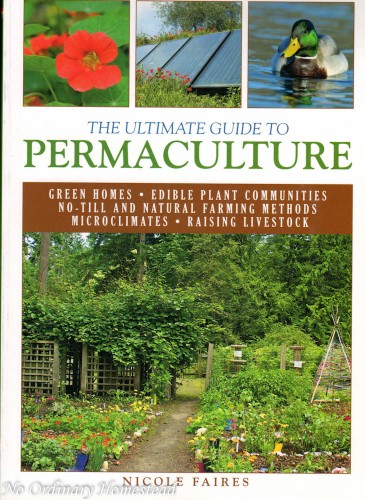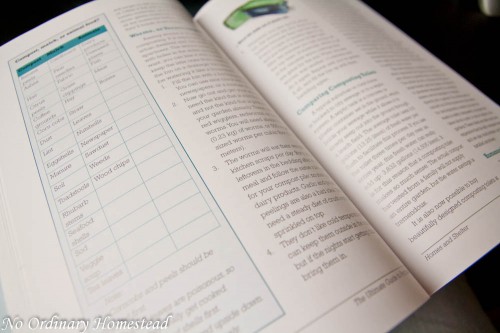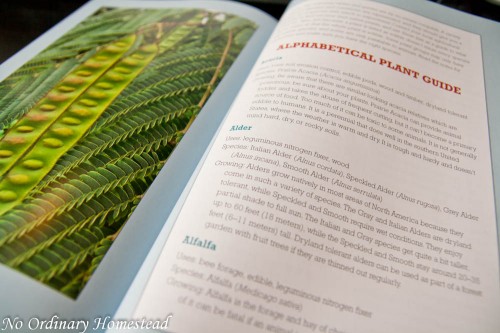Before we got this whole move to Berlin started, I was contacted by Skyhorse Publishing about receiving a few books of theirs for review. I’ve read several of their homesteading books (including The Joy of Hobby Farming) in the past and really enjoyed them, so the book worm in me was thrilled to receive another volume of knowledge from them that I could devour. Choosing just one book from their extensive collection of books on all types of subjects wasn’t easy, especially now that our living situation is just a bit different since we’re not really able to do full scale crop cultivation on our balcony (although it would make for any interesting conversation starter). 😉
At any rate, since I’ve perused Gaia’s Garden in the past (a wonderfully informative book about permaculture) and picked up several useful tidbits from it (like planting in zones dependent on their distance from your cooking/living space), so I was excited to see that there was another comprehensive book about permaculture available.
About the Book
The Ultimate Guide to Permaculture is one woman’s attempt to compile everything she’s personally learned over the years about permaculture and allow you to take a crash course on the materials right in the comfort of your own home.
Permaculture is essentially a way of designing the way you live and eat to coexist harmoniously with ecology. David Holmgren, one of the founders of the concept, described permaculture as “consciously designed landscapes which mimic the patterns and relationships found in nature, while yielding the abundance of food, fiber, and energy for provision of local needs. But as you might imagine, blending ecology, organic agriculture, green home design and biology so that it can be used every day to create a harmonious growing and living environment isn’t easy — but that’s exactly where The Ultimate Guide to Permaculture comes in.
Topics that are covered in depth include:
- Growing edible plant communities and forest gardens
- Using no-till and natural farming methods
- Creating microclimates for extended growing seasons
- Building green homes and passive solar design
- Raising livestock with ecological foraging techniques
- Transforming urban backyards into food-abundant oases
The author, Nicole Faires, is an adventure seeker who grew up living off the land and learning a completely sustainable lifestyle as a child. At the time she wrote The Ultimate Guide to Permaculture, she was actually living in a 37-foot bus with her husband and their 3 daughters. And all the elements of permaculture that she learned and put into this book were honed in as she and her family attempted to leave as little a footprint as possible as the 5 of them sought out daily adventures in their 350-square-foot bus.
What I Thought
The Ultimate Guide to Permaculture provides a great overview of what the principles and elements of permaculture are, and how you can identify your own needs in order to determine which elements you need to include in your surroundings. And then it delves into how to actually create those features to achieve your goals. As with any of the books in homesteading and gardening genres, it’s difficult to cover absolutely everything that there is to know. But I think that the information she has put together is very comprehensive, easy to read and simple put into effect.
One of the sections which I think is particularly useful is the alphabetical plant guide which not only tells you how to grow each plant, but also includes the uses of the plants in the permaculture environment (ie nitrogen fixer, edible parts, wood, bee forage, etc). This is really crucial to know in a permaculture environment where you are attempting to have everything work together in harmony to achieve the ultimate results. This plant guide section spans nearly 50 pages in this 330-page book, and is also broken down into a quick-reference table to give you easy access to the information you need.
There are many other tables and charts within The Ultimate Guide to Permaculture to help the reader achieve a quick grasp of the materials without having to spend hours filtering through the information. Everything from mulching materials to building materials for an in ground water tank to companion plants are covered in these charts.
I also really appreciated the easy-to-read language of the book and the way in which the author introduces you to permaculture so that you fully understand why this is all important and how every decision you make in planning your home, garden or yard will impact your ultimate outcomes.
I have to admit that when we have used permaculture techniques, I’ve found it to be wonderfully simple and helpful — and I will definitely continue to use them in the future. After first starting to learn about permaculture, I discovered that one should plant the vegetables and herbs that you use on a daily basis closest to the door of your home. Now it seems like a super simple idea that most of us could (and maybe have) come up with on our own. But in our case, we never had the idea ourselves. So when we created our courtyard gardening space and grew tomatoes, cucumbers, eggplants, lettuce, herbs and other things we would use on a nearly daily basis as they ripened, it made perfect sense because saw them and could tend to them on a daily basis. We were definitely happier with the final results. Then we reserved the garden space behind our barn for the sprawling squash and pumpkins, the fruit trees and other things that didn’t need quite so much attention from us, which made more sense since we were rarely in that area.
Final Words
If you are looking to create a more harmonious cycle in your garden and yard which will ultimately create less work for you and reap better results, I would absolutely recommend buying a copy of The Ultimate Guide to Permaculture. There is a lot of powerful information here for anyone on a homesteading quest, whether they are working with 1/4-acre of 140 acres. And due to the fact that the author completely takes all elements of your homestead into consideration (from water features to livestock to plants to your home), there is a large amount of information to be gleaned from the pages of this book.
Have you ever tried any permaculture elements in your outdoor living designs?
By the way, be on the look out for an announcement about the Garden Life Link Up coming next week — or hop over to the NOH Facebook page to get a sneak peak and leave your response on the poll! I really appreciate your response!!
Note: I received a free review copy of The Ultimate Guide to Permaculture prior to writing this post. No monetary compensation was provided and the opinion expressed in this review are completely my own. Links contained within this post may be affiliate links, and the purchase of this book via said links will result in me receiving a small commission.
Want to join in the garden fun and link to your own blog or images online? You can share about anything related to gardening, old or new posts, from recipes to harvesting to grow reports to DIY projects or inspiration.
Here’s how this works:
PLEASE READ THESE GUIDELINES, especially if you have never linked up before!
|
That’s it! Share your garden with us by linking up below!






